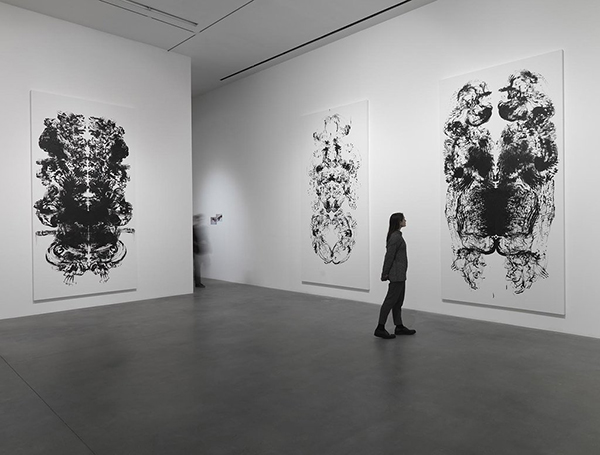Hauser & Wirth London is currently presenting Mark Wallinger’s debut solo exhibition with the gallery. The artist’s latest offering is spread across both Savile Row spaces hosting a presentation of new paintings and multi-media works. Wallinger utilises Sigmund Freud’s terms, id, ego and superego in an interrogation of the psyche, the self, and the subject, playing with the tropes of psychoanalysis, often astute and at the same time amusing.
Upon entering Hauser & Wirth’s North Gallery, the viewer is met with the piece ‘Ego’ (2016). Two iPhone photographs depict the hands of the artist as an amusing recreation of Michelangelo’s ‘Creation of Adam’. The ego is indeed at play, referencing modern narcissism through the obsession with self image, the ‘selfie’ as an act of creation: the mundanity of the ego.
Wallinger plays with the significant and recurrent motifs of the self and its examination, and when I say play: the artist has great fun with it. Not least with Wallinger’s new body of work: the id Paintings. The artist, in part driven by the ‘pleasure principle’ of the id, has created a series of large-scale paintings based on Rorschach test imagery. But instead of creating these works via over-sized inkblots – or recreating these forms in a traditional manner with a brush – Wallinger has created the works using his bare hands.
Freud stated that the id was a source of psychic energy, which is certainly on display in Wallinger’s series of works. The artist uses symmetrical movements to create mirroring on the canvases, which are intentionally the span of Wallinger’s arms. Primal and expressive; the paintings consist of instinctual mark-making, a form of subverted self-portraiture, referencing the artist’s own body and the psychological interpretations of a Rorschach inkblot, asking the viewer to analyse and interpret Wallinger’s ambiguous designs, and in doing so creating their own subjective emotional response.
In the South Gallery, the viewer is met by a new sculptural work, ‘Superego’ (2016). A work that was inspired by the revolving New Scotland Yard sign, but with a mirrored form at its top. A totemic object revolving on a perpetual vigil reflecting the superegos self-critical conscience, reflecting and policing social standards. The projected work ‘Ever Since’ (2012) is a life-sized barber’s shop front, the only element that appears to be moving is the barber’s pole outside, but in fact the projection is comprised of a selection of looping stills forever in motion. Aspects of perpetual looping motion are in fact present in all of the works in the South Gallery, in endless orbits of perception.
The same can be stated of ‘Shadow Walker’ (2011), where the artist captures his shadow walking along Shaftesbury Avenue. Another form of subverted self-portraiture, the work is an attempt to perceive and capture identity, but the piece rapidly assumes the nature of simulacrum as the action becomes autonomous and perpetual.
‘Orrery’ (2016) is a new video work by the artist, and takes its name from the mechanical model that articulates the positions of the planets and moons. The work consists of four screens with the viewer at its centre, its subject the New Fairlop Oak in the centre of Fullwell Cross roundabout in Barkingside, which was planted in 1951 as part of the Festival of Britain to commemorate the legendary Fairlop Oak that had stood for centuries in Hainault Forest. The work is temporal in nature; a perpetual loop juxtaposed with the nature of impermanence and concepts of cycles. No matter the span of time, nothing lasts forever except the work.
The works in the South Gallery act as signifiers of cyclicality. Wallinger’s exploration of identity employs psychoanalytical archetypes as the day turns, and the world spins in a never-ending ouroborus. The ‘prima materia’ of Wallinger’s impressive first exhibition with Hauser & Wirth is man at its centre in perpetual self-reflexivity, as we all go in circles and ruminate over our own identity crisis. This is Wallinger at his best, as he puts us all under analysis.
By Paul Black
Mark Wallinger: ID – Hauser & Wirth London – until 7 May 2016.
























